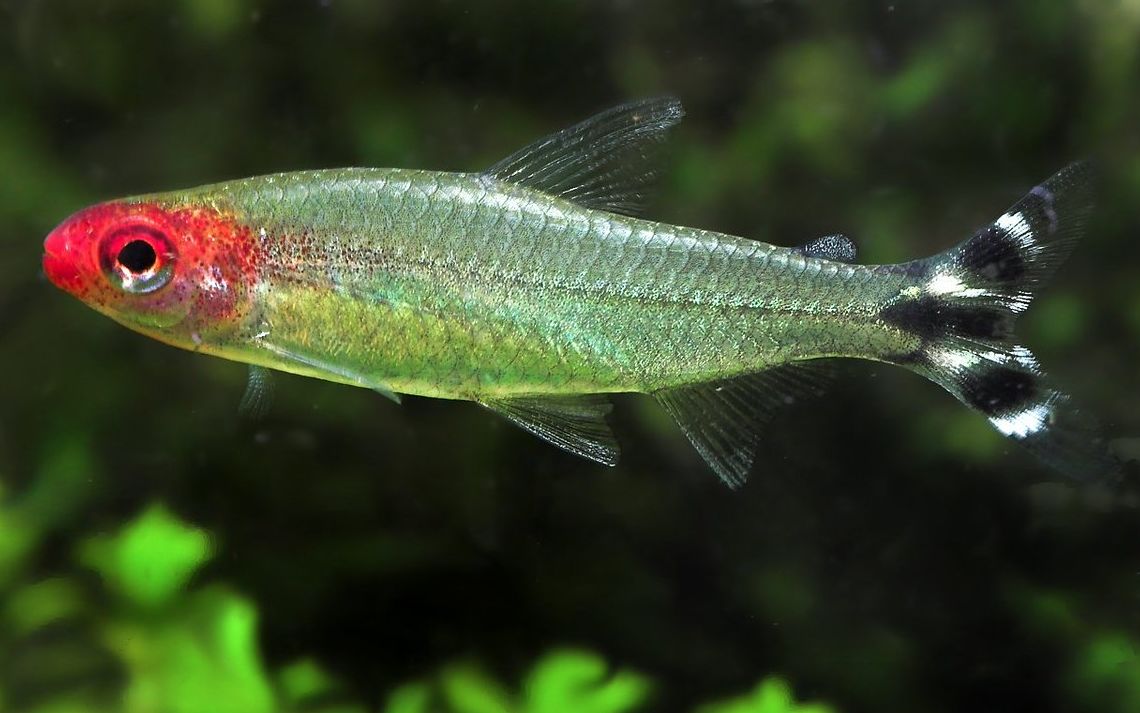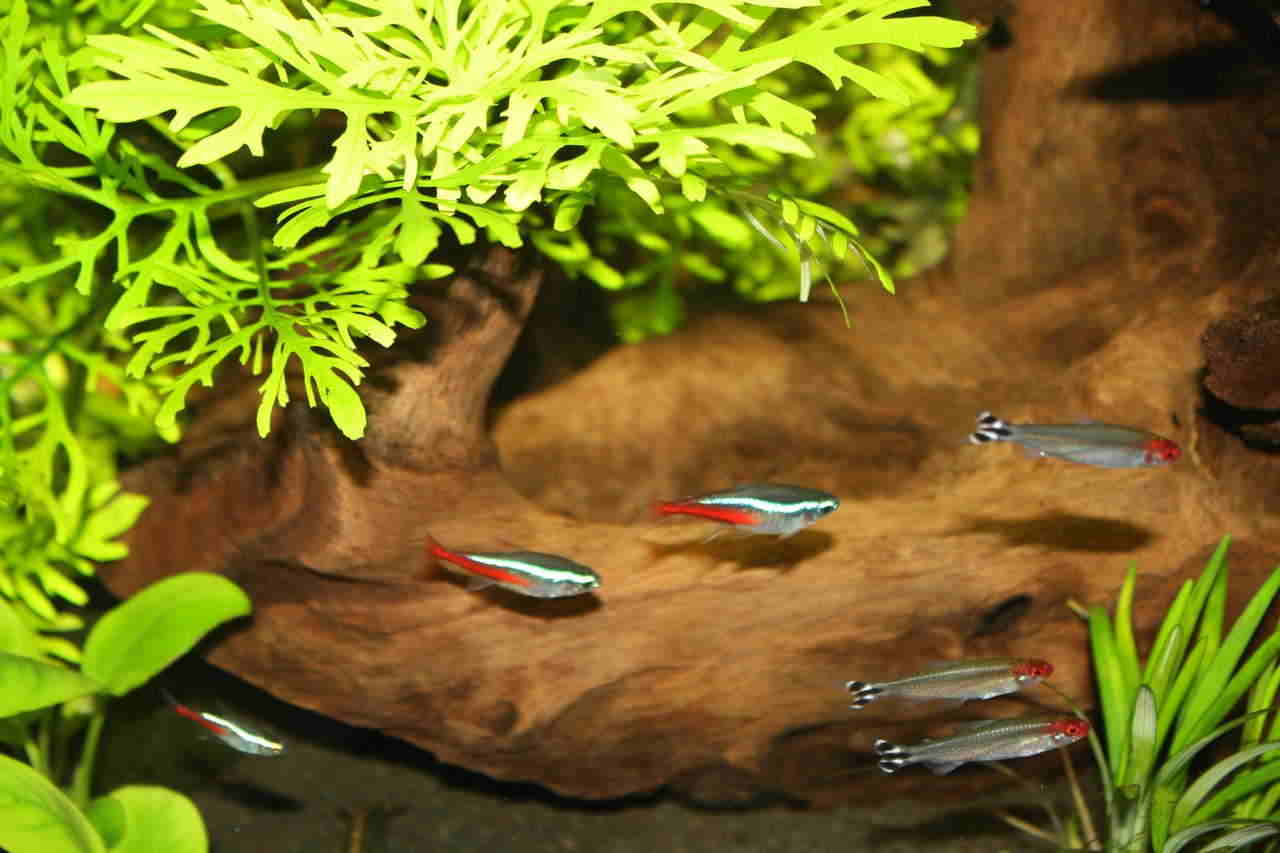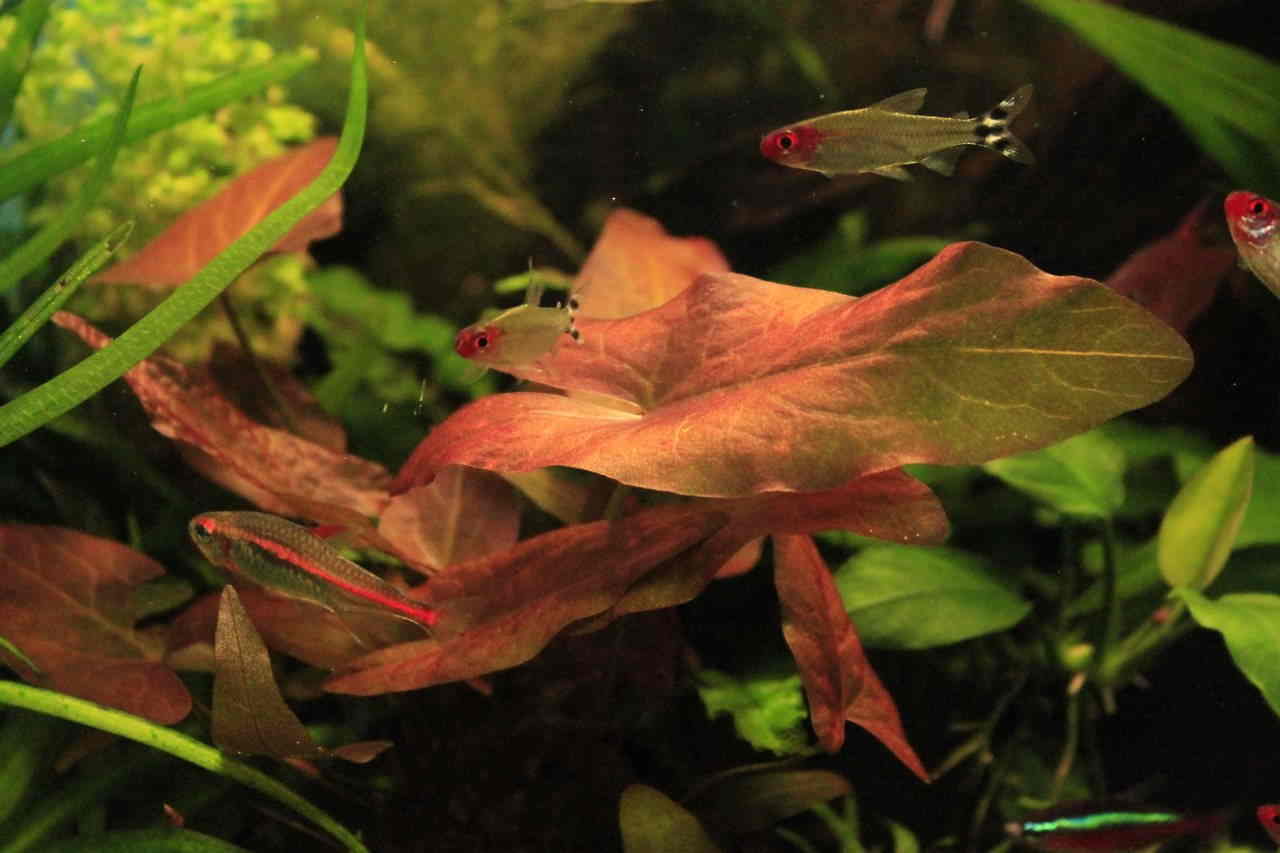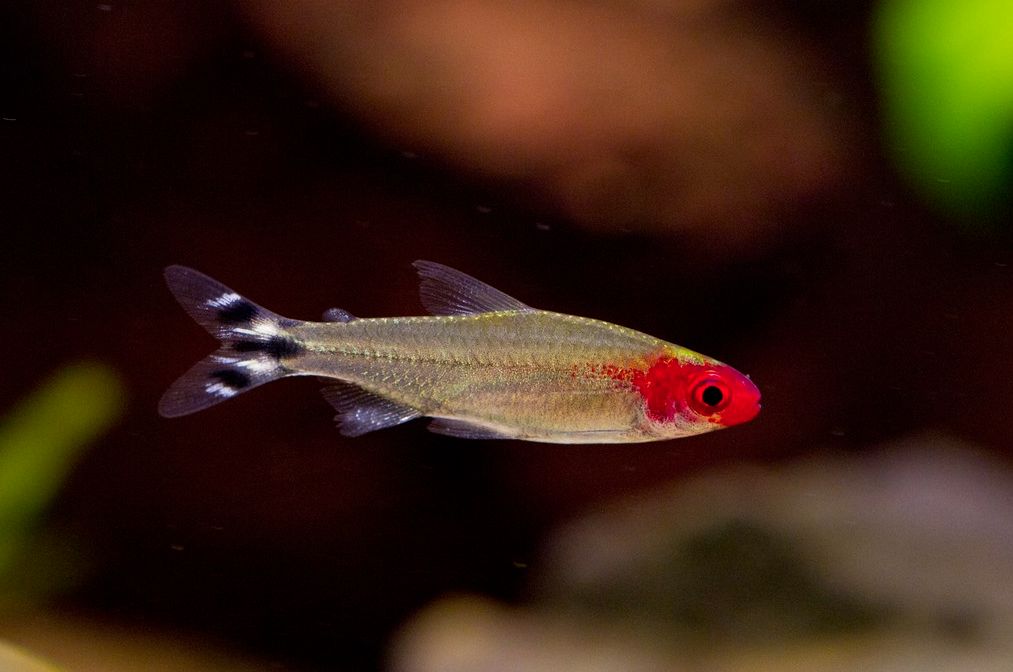The rummy nose tetra is a captivating addition to any aquarium, known for its striking appearance and peaceful demeanor. This small fish reaches about 4.5 cm in length and features a distinctive bright red spot on its head, while its fluke displays beautiful black and white stripes against a silvery body.
Due to its friendly nature, the rummy nose tetra makes an excellent tank mate for other peaceful fish, such as neon tetras or guppies. This species thrives in groups, so it’s best to keep them in schools of at least six to promote their social behavior and overall well-being.

Contents
Habitat in the wild
The rummy nose tetra belongs to the family Characidae, a diverse group of freshwater fish known as characins. This family includes many popular aquarium species, such as tetras, hatchetfish, piranhas, and pencilfish. Rummy nose tetras are primarily found in South America, specifically in the Rio Vaupés in Colombia and the Rio Negro in Brazil, as well as tributaries of the Amazon River. These habitats feature water with a brownish tint and high acidity, resulting from the decomposition of fallen leaves and organic materials on the riverbed.
Interestingly, there are three recognized types of fish referred to as rummy nose tetras. The classic Hemigrammus rhodostomus is the most well-known and commonly kept in aquariums. The brilliant rummy nose (Hemigrammus bleheri), discovered later, inhabits different regions in Brazil. Additionally, there is the Petitella georgiae, or false rummy nose, which prefers waters with higher hardness levels. While these species share similar appearances and care requirements, subtle differences exist that only seasoned aquarists can discern.
Description
Coloring
The rummy nose tetra features a semi-transparent body with a subtle greenish tint. When stressed, the vibrant red coloration of its head can pale significantly, indicating potential water quality issues. The fish has whitish flesh fins and a fluke adorned with three prominent black stripes that are flanked by four thinner white stripes. Additionally, there are three elongated black spots on its tail stem, enhancing its distinctive appearance.
The most notable characteristic of the rummy nose tetra is its bright red spot on the head, which is a key identifier of the species. This coloration can diminish if the water conditions become poor, particularly with high levels of nitrates and ammonia, showcasing the fish’s sensitivity to its environment.
Size
Rummy nose tetras are relatively small, typically growing to about 1.5 to 2 inches (3.8 to 5 centimeters) in length. Their petite size and peaceful nature make them a favored choice for community aquariums, where they can thrive alongside a variety of other non-aggressive fish species.
Lifespan
With appropriate care, including optimal water conditions and a balanced diet, rummy nose tetras can enjoy a lifespan of 3 to 5 years.
| Characteristic | Description |
|---|---|
| Scientific Name | Hemigrammus rhodostomus |
| Common Name | Rummy nose tetra |
| Family | Characidae |
| Origin | South America (Amazon River basin and its tributaries) |
| Maximum Size | Approximately 2 inches (5 centimeters) |
| Lifespan | 3 to 5 years |
| Temperament | Peaceful, non-aggressive |
| Schooling Behavior | Active schooling fish, prefers groups of at least six |
| Water Parameters | pH: 6.0 – 7.5, Temperature: 72°F – 82°F (22°C – 28°C) |
| Tank Size | Minimum 15 gallons for a small group |
| Diet | Omnivorous – Accepts both flake and live/frozen foods |
| Colors | Silver body with red coloration on the nose |
| Compatibility | Generally peaceful and compatible with most community fish |

Difficulties in keeping
The rummy nose tetra is a demanding fish, making it less suitable for inexperienced aquarists. Keeping this species healthy requires a keen focus on water purity and parameters. They are particularly sensitive to ammonia and nitrate levels in the water, which can adversely affect their health if not properly managed.

Care and keeping in a tank
School Size
The number of rummy nose tetras you can keep in an aquarium largely depends on the tank size and available swimming space. As schooling fish, they thrive in groups, which allows them to feel secure and reduces stress, leading to more natural behaviors and better overall health. A minimum group size of six rummy nose tetras is recommended, as this provides them with the necessary security. In larger tanks, you can comfortably house groups of 10 to 15 or even more, depending on the tank’s capacity and compatibility with other species.
It’s essential to create an environment that offers ample swimming space and hiding spots using plants, rocks, and decorations. This will enhance their comfort and well-being. Maintaining proper filtration and conducting regular water changes are also critical for ensuring a healthy habitat for your rummy nose tetras.
Tank Size
For a small group of rummy nose tetras, a minimum tank size of 30 gallons (approximately 114 liters) is advisable. If you intend to keep a larger group or add other fish species, a bigger aquarium will be necessary to accommodate them comfortably. Tanks ranging from 30 to 50 gallons or more are ideal for larger schools and a diverse community setup.
Providing plenty of swimming space along with hiding spots created by live plants, driftwood, and decorations is essential. Keeping the water quality high through effective filtration and regular water changes will further support the health of your rummy nose tetras.
Water Parameters
Rummy nose tetras are more demanding regarding tank conditions compared to many other fish species. Maintaining proper water parameters is vital for their health and well-being. They thrive in soft, acidic water similar to their natural blackwater habitats. It’s important to avoid introducing them to a new, unbalanced tank, where water parameters are still fluctuating.
Here are the recommended water parameters for rummy nose tetras:
- Temperature: 72°F to 82°F (22°C to 28°C)
- pH: 6.0 to 7.5
- Hardness: 2 to 10 dGH (general hardness)
- Ammonia and Nitrite: 0 ppm (parts per million)
- Nitrate: Below 20 ppm (regular water changes can help control nitrate levels)
Using an external filter is advisable due to their sensitivity to ammonia and nitrates. Regularly renewing the water—approximately 30% of the tank capacity each week—along with utilizing an efficient filtration system, will help restore and maintain their vibrant colors.
Lighting
The lighting in the tank should be dim, as rummy nose tetras naturally inhabit areas shaded by trees and leaves. A well-balanced, densely planted tank will make the school feel comfortable and secure. Creating a suitable environment will encourage healthy behaviors and vibrant coloration in your rummy nose tetras.

Diet
Rummy nose tetras are omnivorous fish, meaning they consume a combination of plant matter and small animal foods. In their natural habitats, they primarily feed on small insects, insect larvae, zooplankton, and various types of plant matter.
In an aquarium setting, it’s essential to provide a varied diet to meet their nutritional needs. Rummy nose tetras can eat a wide range of food types, including live, frozen, and formulated feeds. A balanced diet for rummy nose tetras may include:
- High-Quality Flakes or Pellets: Choose specially formulated tropical fish flakes or pellets designed for small tropical fish. These products should contain a variety of nutrients to support their health.
- Live or Frozen Foods: Offer occasional treats of live or frozen foods such as brine shrimp, daphnia, mosquito larvae, or bloodworms. These foods are rich in essential proteins and nutrients that promote their vibrant colors and overall vitality.
It’s important to feed rummy nose tetras in small portions that they can consume within a few minutes. Overfeeding can lead to poor water quality and health issues. Generally, feeding them 2-3 times a day is recommended, with the amount adjusted based on their appetite and the number of fish in the tank.
Tank mates
Rummy nose tetras are peaceful and schooling fish, thriving best in groups. Care should be taken during transportation, as they can become easily frightened. This stress may lead to shock, causing them to freeze, move erratically, or darken in color. Such distress can be life-threatening, so it’s crucial to handle them gently and ensure a calm environment during transfers.
In the wild, they are found in large schools, which is essential for their psychological well-being; keeping them in groups of six or more is highly recommended in aquariums. Within their schools, rummy nose tetras may establish social hierarchies, with dominant individuals often displaying bolder behaviors.
Additionally, rummy nose tetras should never be housed with large or predatory fish, as their small size and timid nature make them vulnerable. Instead, they flourish in community tanks with other small, peaceful species that share similar environmental needs.
Tank mates can be:
- Harlequin Rasboras (Trigonostigma heteromorpha)
- Neon Tetras (Paracheirodon innesi)
- Ember Tetras (Hyphessobrycon amandae)
- Glowlight Tetras (Hemigrammus erythrozonus)
- Black Neon Tetras (Hyphessobrycon herbertaxelrodi)
- Cardinal Tetras (Paracheirodon axelrodi)
- Dwarf Gouramis (Trichogaster lalius or Trichogaster chuna)
- Sparkling Gouramis (Trichopsis pumila)
- Celestial Pearl Danios (Danio margaritatus)
- White Cloud Mountain Minnows (Tanichthys albonubes)
- Dwarf Rasboras (Boraras spp.)
- Endler’s Livebearers (Poecilia wingei)
- Guppies (Poecilia reticulata)
- Platies (Xiphophorus spp.)
- Corydoras Catfish (Corydoras spp. – pygmy cory, panda cory, adolfoi catfish)
- Otocinclus Catfish (Otocinclus spp.)
- Bristlenose Plecos (Ancistrus spp.)
Gender differences: male vs female
Identifying male and female rummy nose tetras can be quite challenging due to minimal sexual dimorphism, meaning both sexes share similar body shapes and coloration. Both male and female rummy nose tetras typically have a silver body with a striking red coloration on their nose and face. However, in healthy and well-maintained individuals, males may display a more intense red color covering a larger portion of their nose and body.
The most reliable method for distinguishing between the sexes is through behavioral observation during spawning. Female rummy nose tetras will become noticeably plumper as they fill with eggs, while males may exhibit more vibrant colors to attract mates and establish dominance. In general, unless you are a seasoned breeder or closely monitor spawning behavior, visually differentiating the sexes can be quite difficult. In community aquariums, knowing their sex is usually less important, as they are primarily appreciated for their appearance and schooling behavior.
Breeding Rummy Nose Tetras
Rummy nose tetras typically reach reproductive maturity between 8 to 12 months of age, depending on tank conditions. For breeding, an optimal spawning tank size is approximately 50×40×40 cm, with a water level of about 15 cm.
Preparation for Breeding:
- Selecting Males: It’s important to carefully choose males for breeding. Fish that are about to spawn should be separated beforehand and fed a varied diet of live foods.
- Adjusting Conditions: Gradually raise the water temperature by 1-2°C, decrease hardness to 4-6 dGH, and maintain a pH level between 6.6 and 6.8.
- Water Quality: Use a mixture of rainwater, settled water, and some turfy brew for the breeding tank. Ensure the water is thoroughly filtered and prepared several days before introducing the fish.
Breeding Process:
- Set optimal water parameters: hardness 2-4 dGH, pH 6-6.2, temperature 25-27°C.
- If spawning does not occur within 1-2 days, gradually increase the temperature and then lower it, adding ozonized settled water as needed.
- During spawning, the male actively chases the female, leading her to the surface where she will often pause beneath a plant leaf. The male will turn and bend the female, releasing 6-7 large, transparent eggs onto the plants and substrate.
Post-Spawning Care:
- After spawning, both parents should be removed to prevent them from eating the eggs. The breeding tank should be shaded with dark paper.
- Eggs will incubate for approximately 24 hours, and the fry will begin swimming around six days after hatching.
- Rummy nose tetra juveniles are larger compared to those of other tetra species and are not particularly demanding in terms of diet. They can be fed cyclops dust or rotifers.
Growth and Development of Juveniles
Within a month, juvenile rummy nose tetras will start to show adult coloration, developing the distinctive red on their heads and black and white stripes on their tails. By four months, their sex can be determined, and by six to eight months, they are ready for breeding. The spawning period lasts approximately 7-10 days. As the juveniles grow, gradually hardening the water can help them adapt to their future environment.